Development Bureau
Energizing Kowloon East Office
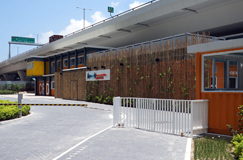
The EKEO Temporary Office is located near the junction of Hoi Bun Road and How Ming Street in close proximity to both Kai Tak Development and the business areas within Kowloon East. It is a two-storey 1,200 m2 floor area building which can accommodate 20 staff and 50 visitors out of an area of 3,600 m2 underneath the Kwun Tong Bypass. On one side of the EKEO building, there are office facilities around a central courtyard; and on the other side, there is an Information Kiosk comprising a briefing area, conference rooms, interpretive set-ups including models and information panels.
The innovative and green EKEO building is the first temporary office building which is given the Building Environmental Assessment Method (BEAM) Plus NB V1.1 Platinum rating endorsed by the Hong Kong Green Building Council in Hong Kong, demonstrating various environmental benefits:
- About 33% or 48,500kWh/year reduction of annual energy consumption
- About 37% reduction in peak electricity demand
Trade and Industry Department
Education Path at Trade and Industry Tower
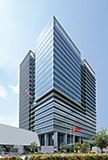
The project has achieved Platinum rating in the Provisional Assessment Stage of the Building Environmental Assessment Method (BEAM Plus). Also, the project is LEED® certified to Platinum level. Major sustainable features in the project include:
- double glazing and sunshades;
- connection to District Cooling System for air-conditioning;
- building integrated photovoltaic panels and photovoltaic panel;
- solar hot water system;
- solar chimney system;
- daylight sun-tube, solar tracking optic fiber light pipe and anidolic light pipe;
- lift regenerative power;
- automatic refuse storage system, drip irrigation system and water saving sanitary devices;
- material with recycled contents, adaptive and modular design for office area.
An education path is created for the public to understand the sustainable features incorporated in the project.
Environmental Protection Department
Community Green Stations
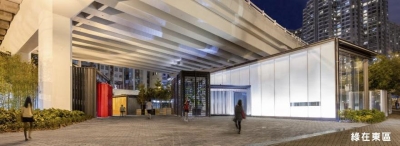
In May 2013, the Environment Bureau published “Hong Kong Blueprint for Sustainable Use of Resources 2013–2022” (“The Blueprint”) setting out the target to reduce the per capita disposal rate of municipal solid waste (MSW) by 40% by 2022. To achieve this target, Hong Kong people should make concerted efforts to put the new green culture of “Use Less, Waste Less” into practice and treasure the resources on earth. The government will develop a Community Green Station (CGS) in each of the 18 districts, which will be operated by non-profit-making organisations to enhance environmental education and help collect different types of recyclables (especially those of low economic value recyclables including electrical appliances, computers, glass beverage bottles, compact fluorescent lamps and tubes, rechargeable batteries, etc.) in the local community, with a view to promoting green living at the community level. This is to, on the one hand encourage more public participation in waste reduction and recovery to increase the quantity of materials recovered and, on the other hand, promote the “Recycle Clean” concept to enhance both quality and quantity of the recyclables collected.
Address:
| Project | Operator | Location |
|---|---|---|
| Sha Tin CGS | Christian Family Service Centre | 10 On Ping Street, Shek Mun, Sha Tin |
| Eastern CGS | Po Leung Kuk | 30 Oi Shun Road, Shau Kei Wan |
| Kwun Tong CGS | Christian Family Service Centre | 27 Sheung Yee Road, Kowloon Bay |
| Yuen Long CGS | Hong Chi Association | 65 Tin Wah Road, Tin Shui Wai |
EcoPark Visitor Centre
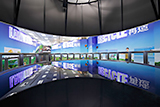
The Visitor Centre (hereinafter "the Centre"), with an area of 1,000 square meter, is situated in the South Wing of the Administration Building of EcoPark. It is the first large-scale education resource centre in Hong Kong with the theme of municipal waste. The primary purpose of the Centre is to provide information about waste management and waste reduction to the visiting public through educational promotion and outreaching programmes, with a view to arousing community awareness on relevant environmental issues, and improving the environmental ethic within the community. The ultimate goal of the Centre is to find a long-term solution for the environmental problem so that a clean, thriving and sustainable city can be developed.
The Centre consists of 8 zones, including Waste Corridor, Movie Area, 1:1 3-D Landfill Model, 3Rs Zone, Product Gallery, Reflection Pond and Group Game Zone. With interesting 3-D technology, advanced multimedia design, interactive games and movies demonstrating the importance of environmental protection, visitors' understanding of municipal solid waste management in Hong Kong and environmental awareness can be enhanced, encouraging them to rethink about 3Rs - "Reduce", "Reuse" and "Recycle" and put green living style into practice.
133, Lung Mun Road, Tuen Mun Area 38, N.T.
Wan Chai Environmental Resource Centre
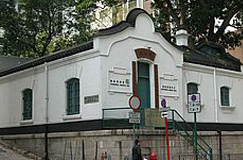
The building of Wan Chai Environmental Resource Centre was constructed in 1913. It was used as the Wan Chai Post Office from 1915 to 1992 and was declared as a historical building in 1990. It was renovated and became the first Environmental Resource Centre of the Environmental Protection Department in 1993. It is one element of the government's effort in building up an environmentally aware and well-informed community in Hong Kong - an essential first step in developing an improved environmental ethic within the community.
221 Queen's Road East, Wan Chai
Fanling Environmental Resource Centre
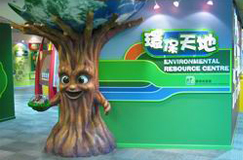
Fanling Environmental Resource Centre provides services for the public with easy access to environmental information and it is a venue for environmental education for schools, community organizations and residents in New Territories North. The total floor area of the Centre is about 400 square metres. Environment-friendly materials are widely used in internal fitting out, and the furniture in the Centre is largely made from recycled materials. Following the success of the first and second Environmental Resource Centres in Wan Chai and Tsuen Wan, Fanling Environmental Resource Centre is the third and the largest Environmental Resource Centre of the Environmental Protection Department.
Floor 2 Government Accommodations, Grand Regentville, 9 Wo Mun Street, Luen Wo Hui, Fanling
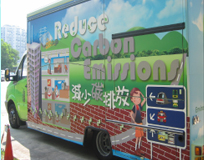
Mobile Environmental Resource Centre
The Mobile Environmental Resource Centre will pay visits to schools, housing estates and commercial centres. Through this convenient gateway, citizens can easily obtain resource materials and messages on environmental protection.
Environment Protection Department and University of Hong Kong
Lung Fu Shan Environmental Education Centre
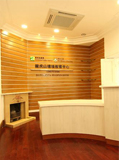
Lung Fu Shan Environmental Education Centre (the Centre) was jointly established by the Environmental Protection Department (EPD) of the Hong Kong Special Administrative Region Government and the University of Hong Kong (HKU) in April 2008. Its daily operation is managed by the Kadoorie Institute of HKU and is overseen by a management committee consisting of representatives from EPD and HKU together with invited co-opted members from experts in the field of ecology, environmental education and sustainability.
Being one of the environmental education centres in Hong Kong, we are committed to: Promote environmental education and encourage public's appreciation of the natural and built environments through interactive learning experiences; and Enhance public awareness towards sustainability issues and low carbon living.
No.50, Kotewall Road, Mid-Levels, Hong Kong (near University Drive entrance)
Leisure and Cultural Services Department
Green Education and Resource Centre
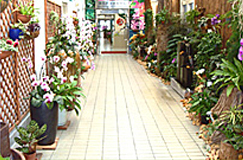
The Green Education and Resource Centre in Kowloon Park was set up to promote environmental protection and greening activities. Covering 800 square metres, the Centre includes an exhibition gallery, lecture rooms, a technical library, a conference room and an outdoor activity area.
Floor 1 Kowloon Park Management Office, 22 Austin Road, Tsim Sha Tsui
Jockey Club Environmental Conservation Gallery
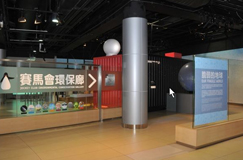
The Earth on which humans rely for survival possesses a wealth of natural resources and wildlife. The activities of various life forms can influence the balance of this intertwined ecosystem. A balanced ecosystem is essential for life to flourish as any imbalance may have disastrous consequences. Through the Jockey Club Environmental Conservation Gallery, we hope to convey the importance of environmental conservation to the public. Visitors are encouraged to adopt sustainable lifestyles and to use our natural resources wisely.
G/F Exhibition Hall, Science Museum, 2 Science Museum Road, Tsimshatsui East
Planning Department
City Gallery

The City Gallery is the first planning and infrastructure gallery in Hong Kong. It is a unique exhibition venue featuring Hong Kong's major planning proposals and infrastructure projects. It also shows us our city's future development outlook.
Hong Kong Science and Technology Parks Corporation
Green Trail
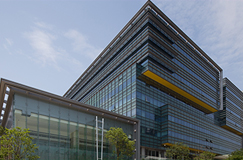
Hong Kong Science Park Phase 3 is a "living laboratory" where the buildings are designed on sustainability principles and make use of three key design principles of reduction, efficiency and generation to encourage smarter use of resources and a greener lifestyle at workplace.
The Phase 3 master plan received the Grand Award in the New Building Category (Building Project under Design) in the Green Building Awards 2012. Phase 3 Building 12W has also been awarded the LEED Platinum (Core and Shell) by US Green Building Council in 2014.
The Green Trail walks you through 17 selected green building design features in Phase 3. Along the way, you can enjoy the tranquil landscape of the Park and at the same time, discover how technological innovations have emerged into modern architectural design and shape our way towards a greener future.
Phase 3, Hong Kong Science Park, Shatin
Green Concepts
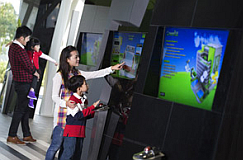
As the prototype to demonstrate and evaluate the green technologies to be employed in Hong Kong Science Park Phase 3, Green 18 is awarded the Platinum Standard by BEAM Society and deploys sustainable features including the following:
- Natural daylight utilisation
- Solar water heater
- Energy efficient lighting
- Office energy management
- Operable vertical louver façade
- Wind turbine
- Rainwater recycling system
- Hybrid ventilation
- Green roof
To encourage and facilitate sustainable development in the Territory, Green 18 not only takes the lead to embrace green features in its design and management practices, but also acts to educate the public by setting up an interactive exhibition, namely Green Concepts. Visitors can understand the principles and energy efficiency concept behind every feature via the click-and-learn information booths.
18 Science Park East Avenue, Hong Kong Science Park, Shatin
The Chinese University of Hong Kong and Hong Kong Jockey Club
Jockey Club Museum of Climate Change
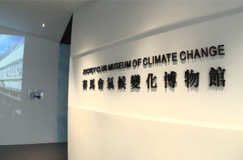
The first of its kind in Hong Kong, the Jockey Club Museum of Climate Change (MoCC) offers an interactive and multimedia exhibition showcasing valuable collections and information about climate change. It is an ideal venue for students, teachers and the public to keep themselves abreast of the latest developments on environmental conservation and sustainability. Extended activities of the MoCC exhibition include eco tour guiding visitors around the prime ecological sites and energy efficient devices on the vast CUHK campus, as well as workshops enabling visitors to participate in hands-on activities related to green living.
The MoCC is within 3-minute walking distance from the University MTR Station, providing an easily accessible venue for the public with innovative green exhibition and activities. Green building principles are adopted as one of the important architectural concepts in aspects such as introduction of day lighting, and solar shading devices, as well as energy conservation and renewable energy usage.
Yasumoto International Academic Park, 8th Floor, The Chinese University of Hong Kong, Shatin
CLP Power Hong Kong Limited
ElectriCity
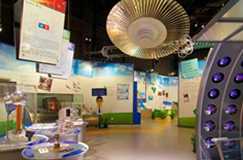
The centre features interesting and informative displays that explain the fundamental principles of electricity, power generation, transmission and distribution. In addition, visitors get to learn more about the fuel sources currently used in Hong Kong.
Castle Peak Power Station ('B' Station), Lung Yiu Street, Tap Shek Kok, Tuen Mun